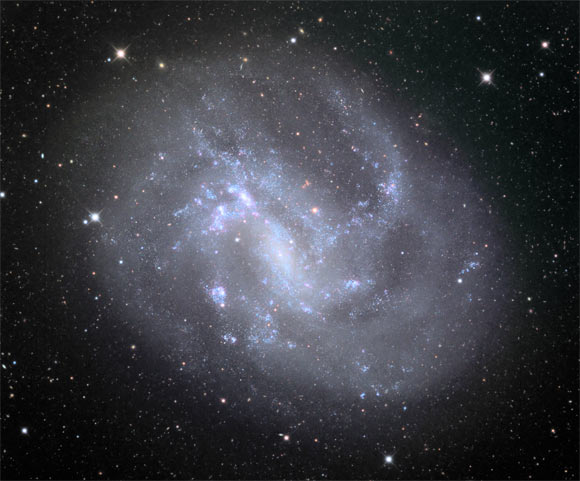An international team of astronomers has found that the central black hole of the nearby spiral galaxy NGC 4395 has a mass of about 10,000 solar masses — about 40 times lighter than previously thought.

NGC 4395 is located in the constellation of Canes Venatici, approximately 14 million light-years away. Image credit: Mount Lemmon Observatory / CC BY-SA 4.0.
“The question remains open for small or dwarf galaxies: do these galaxies have black holes, and if they do, do they scale the same way as supermassive black holes?” said University of Michigan astronomer Elena Gallo.
“Answering these questions might help us understand the very mechanism through which these monster black holes were assembled when the Universe was in its infancy.”
To determine the mass of NGC 4395’s black hole, Dr. Gallo and her colleagues from Seoul National University, San Diego State University, the University of Michigan and the University of Science and Technology, Hefei employed a technique called reverberation mapping.
This method measures mass by monitoring radiation thrown off by what’s called an accretion disk around the black hole.
As radiation travels outward from this accretion disk, it passes through another cloud of material farther out from the black hole that’s more diffuse than the accretion disk. This area is called the broad-line region.
When the radiation hits gas in the broad-line region, it causes atoms in it to undergo a transition. This means that the radiation bumps an electron out of the shell of an atom of hydrogen, for example, causing the atom to occupy a more energetic level of the atom.
After the radiation passes, the atom settles back into its previous state. Astronomers can image this transition, which looks like a flash of brightness.
By measuring how long it takes for the accretion disk radiation to hit the broad-line region and cause these flashes, they can estimate how far the broad-line region is from the black hole. Using this information, they can then calculate the black hole’s mass.
“The distance is thought to depend on the black hole mass. The larger the black hole, the larger the distance and the longer you expect for light to be emitted from the accretion disk to hit the broad-line region,” Dr. Gallo said.
Using data from the MDM Observatory, the team calculated that it took about 83 minutes, give or take 14 minutes, for radiation to reach the broad-line region from the accretion disk.
To calculate the black hole mass, the researchers also had to measure the intrinsic speed of the broad-line region, which is the speed at which the region cloud is moving under the influence of the black hole gravity.
To do this, they took a high-quality spectrum with the Gemini Multi-Object Spectrograph (GMOS) on the Frederick C. Gillett Gemini North telescope.
By knowing this number, the speed of the broad-line region, the speed of light and what’s called the gravitational constant, the scientists were able to determine that the black hole’s mass was about 10,000 times the mass of our Sun. This is also the smallest black hole found via reverberation mapping.
“This regime of dwarf galaxies is largely unexplored when it comes to the properties of their nuclear black holes,” Dr. Gallo said.
“We don’t even know if every galaxy has a black hole. This adds a new member to the family of black holes we have information about.”
The team’s results appear online this week in the journal Nature Astronomy.
_____
Jong-Hak Woo et al. A 10,000-solar-mass black hole in the nucleus of a bulgeless dwarf galaxy. Nature Astronomy, published online June 10, 2019; doi: 10.1038/s41550-019-0790-3







